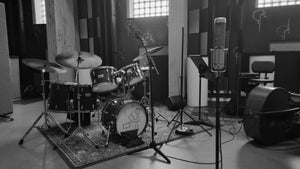Die Kunst der Aufnahme mit nur einem Mikrofon
Die perfekte Balance finden mit dem Josephson C700S
Bei Sound Liaison sind wir bekannt für unser Engagement für hochauflösende, natürlich klingende Aufnahmen, die die Essenz einer Live-Performance einfangen. Eine unserer besonderen Techniken ist die Ein-Mikrofon-Aufnahme , insbesondere mit dem unglaublich empfindlichen und detailreichen Josephson C700S Mikrofon. Diese Methode reduziert die Aufnahme auf ihre authentischste Form: ein Mikrofon, ein Raum, eine Aufnahme.
In diesem Blogbeitrag gehen wir der Frage nach, wie wir bei Aufnahmen mit nur einem Mikrofon in Studio 2 vorgehen, und konzentrieren uns dabei auf die wichtigsten Elemente: Mikrofonplatzierung, Positionierung der Musiker, Raumakustik und Balance der Performance .
Warum nur ein Mikrofon für Aufnahmen verwenden?
Bevor wir uns mit den technischen Details befassen, lohnt es sich, noch einmal zu erläutern, warum wir die Ein-Mikrofon-Methode so schätzen. Ein einzelnes Mikrofon bedeutet keine Phasenprobleme, keine Nachbearbeitung beim Mischen und eine direkte Verbindung zwischen Musikern und Zuhörer. Das Ergebnis ist ein intimer, dynamischer und wahrhaft dreidimensional wirkender Klang, als stünde man direkt mit der Band im selben Raum.
Schritt eins: Den optimalen Platz in Studio 2 finden
Der erste und wohl wichtigste Schritt bei einer Aufnahmesession mit nur einem Mikrofon ist die exakte Positionierung des Mikrofons. In Studio 2 beeinflusst jede Ecke, jede Deckenhöhe und jede Oberfläche den Klang. Deshalb beginnen wir damit, durch den Raum zu gehen, in die Hände zu klatschen, zu sprechen und sogar in verschiedenen Bereichen Instrumente zu spielen.
Wir suchen nach einem Ort, an dem der Klang besonders gut zur Geltung kommt, wo Reflexionen und Direktschall harmonisch und musikalisch verschmelzen. Oft liegt dieser Ort nicht genau in der Mitte oder in Wandnähe, sondern dort, wo sich die Raumenergie auf natürliche Weise konzentriert. Mit der Zeit entwickelt man ein Gespür dafür, doch genaues Hinhören ist immer unerlässlich.
Die Höhe ist entscheidend: Nicht zu hoch, nicht zu niedrig
Sobald wir den optimalen Standort auf dem Boden gefunden haben, berücksichtigen wir die Höhe des Josephson C700S . Dieses Mikrofon nimmt dreidimensionalen Klang auf (XY und Omni), daher beeinflusst seine Höhe die Raumwahrnehmung erheblich.
-
Ist die Lautstärke zu niedrig , klingt die Aufnahme dumpf, wird von Bodenreflexionen dominiert und die Klarheit lässt nach.
-
Ist die Einstellung zu hoch , wird der Klang dünn und distanziert, verliert an Wärme und Intimität.
Unser Ziel ist ein Klang, der sich anfühlt, als stünde man direkt vor der Band. Wir beginnen üblicherweise mit einer Position etwa auf Brust- bis Kopfhöhe einer stehenden Person und passen die Position zentimeterweise an, bis das Klangbild voll und authentisch wirkt.

Die Perspektive der Band: Realität vs. Regieraum
Bei der Positionierung von Musikern ist zu beachten, dass das, was wir im Studio sehen, nicht unbedingt dem entspricht, was wir im Regieraum hören . Das Josephson C700S erfasst räumliche Details präzise, sodass selbst geringfügige Änderungen des Winkels oder der Entfernung einen erheblichen Einfluss auf das Stereobild und die Tiefenwirkung haben können.
Wir wollen kein traditionelles Bühnenbild nachbilden. Stattdessen erschaffen wir das Bild, das der Zuhörer hören soll:
-
Die Links-Rechts-Panning-Bewegung wird durch die seitliche Positionierung der Musiker relativ zum Mikrofon gesteuert.
-
Die Tiefe (Abstand zum Mikrofon) bestimmt die Präsenz; näher liegende Instrumente klingen lauter und intimer.
Musiker sind oft überrascht, wenn sie feststellen, dass schon wenige Zentimeter Abstand zum Mikrofon dazu führen können, dass sie im fertigen Mix einen Meter weiter vorne oder weiter hinten klingen. Deshalb nehmen wir uns Zeit, jeden Musiker individuell zu positionieren und anschließend anhand von Testaufnahmen Feineinstellungen vorzunehmen.
Eine lebendige Mischung: Die Rolle der Bewegung
Bei der Aufnahme mit nur einem Mikrofon gibt es keine Faderautomatisierung, die Balance ergibt sich also aus der Performance .
Wir ermutigen Musiker, wie Ingenieure zu denken. Wenn ein Saxophonist ein Solo spielt, muss er möglicherweise etwas nach vorne treten , um das Solo in den Vordergrund zu rücken. Ebenso kann eine Backgroundsängerin etwas zurücktreten, wenn sie nicht die Hauptstimme singt.
Diese Bewegungen müssen minimal sein, nur ein Schritt oder gar eine leichte Vorbeuge, aber sie machen im Regieraum einen enormen Unterschied. Es ist ein Tanz zwischen den Musikern und dem Mikrofon, der zum natürlichen Fluss der Performance beiträgt. Der letzte Check: Zuhören wie ein Zuhörer
Sobald alle an ihrem Platz sind und wir ein paar Testläufe absolviert haben, gehen wir in den Regieraum und hören genau hin . Fühlt es sich an, als wäre man selbst im Raum? Stimmt der Groove? Baut sich die Dynamik natürlich auf? Falls nicht, gehen wir zurück in den Regieraum, justieren nach und wiederholen den Vorgang.
Aufnahmen mit nur einem Mikrofon erfordern Geduld und Zusammenarbeit, aber das Ergebnis ist eine echte Klangbühne, in der Performance, Raum und Aufnahme zu einer Einheit verschmelzen.

Warum es für Sie wichtig ist
Wenn Sie eine One Mic Recording von Sound Liaison hören, erleben Sie die Atmosphäre des Raumes hautnah. Keine Bearbeitungen, keine Overdubs, kein künstlicher Hall. Nur Musiker im Raum, detailreich und dreidimensionale Klangwiedergabe vom Josephson C700S eingefangen.
Dieser Ansatz spiegelt unsere Überzeugung wider, dass großartiger Klang keine Tricks braucht, sondern die Wahrheit .
Entdecken Sie unsere One Mic-Aufnahmen auf www.soundliaison.com und hören Sie selbst, wie Reinheit, Präzision und Platzierung zusammenwirken, um ein wahrhaft immersives Hörerlebnis zu schaffen.

